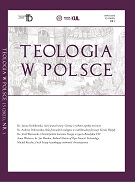Jednym z założeń chrystologii scholastycznej było przekonanie o potrzebie i możliwości tworzenia modeli teologicznych unii hipostatycznej. Jako konstrukty teoretyczne miały one ułatwiać stawianie nowych hipotez na danym odcinku teologii. Jak wskazuje na to autor niniejszego artykułu, znaczące średniowieczne próby ukazania unii hipostatycznej przy pomocy właściwego odwzorowania przejawiały się w twórczości Piotra Abelarda, Bonawentury i Alberta Wielkiego. Sugerując jedynie szerszą perspektywę, modele powyższe rzadko rozwijały swoje intuicje. Dlatego w drugiej kolejności czytelnik zapoznaje się z bardziej już systematyczną panoramą XIII-wiecznej chrystologii: z trzema funkcjonującymi naówczas teoriami, wyartykułowanymi przez Piotra Lombarda w jego Sentencjach. Określają one granice średniowiecznej refleksji chrystologicznej, a zarazem stanowią bezpośredni grunt myśli Tomaszowej, która – krytycznie stosując model całośćczęść – jest ostatnim najważniejszym przedmiotem analiz tego artykułu.
THE MEDIEVAL MODELS AND THEORIES OF THE HYPOSTATIC UNION – THE BACKGROUND AND THE STRUCTURE OF SAINT THOMAS AQUINAS’ CHRISTOLOGY.
Summary
One of the principles of the scholastic Christology was the conviction about the necessity and possibility of creating the hypostatic union’s theological models. As theoretical constructions their roles were to make presenting of the new theological hypotheses easier. As the author of this article points out, remarkable medieval attempts of showing the hypostatic union with the correct patterns could be found in the works of Peter Abelard, Saint Bonaventure and Albert the Great. These models were rarely developing their intuitions suggesting the wider perspective only. Because of that the reader learns about systematic panoramic view of the 13th century Christology in the second turn. These are the three existing in that time theories pronounced by Peter Lombard in his Sentences. They define the limits of the medieval Christological reflection and they are the basis of Aquinas’ thought which by critically using the whole-part model is the most important subject of this article.
Ostatnia aktualizacja: 25.03.2012, godz. 23:57 - Natalia Haniewska































